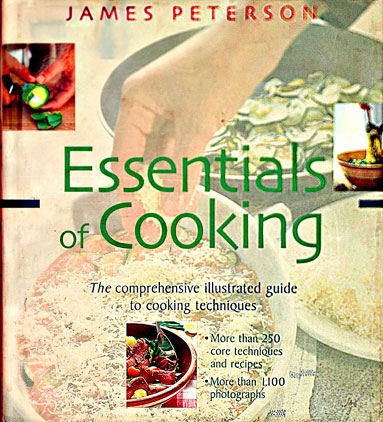At it’s most basic, a broth is simply the result of cooking meat, vegetables, or seafood in water. Broth is either white or brown depending on whether the meat and/or other ingredients are first browned.
Broth is ultimately simple to make, but there are a few dos and don’ts. First, don’t add too much water to the solid ingredients—add just enough to cover and if the liquid evaporates some during the cooking, you can add a little water as the cooking progresses. Don’t worry about making the broth too strong as you can always water it down if needed. If it starts out too weak, you’ll have to reduce it to concentrate it. Second, always start out with cold liquid. If the liquid is initially hot, proteins will release liquid containing dissolved albumin. This albumin will hit the hot liquid and coagulate into a very fine cloud that is hard to eliminate. If, on the other hand, you start out with cold water, the albumin is released more slowly and has a chance to tangle up with itself and rise to the top of the pot as froth, which can be skimmed off. Third, broth should never be allowed to boil. If it is, fats and froth that would normally float to the top, get churned back in and make the broth cloudy and greasy. Fourth, the broth should be more or less constantly skimmed to eliminate coagulated proteins and fat that float to the top.
Why is it, that despite taking these precautions, our broth sometimes ends up cloudy? You’ll probably notice this happens less often with brown broth (broth for which the proteins and vegetables are first browned) than with white broth. This is because the browning process coagulates the proteins before liquid is added. When making white broth with veal, be sure to blanch the meat or bones before adding liquid. This gets rid of the albumin and does nothing to eliminate savor. Chicken is different. When making chicken broth with meat, the broth should end up perfectly clear whether the chicken has been cooked first or not—the only advantage to first browning it is for color and a more pronounced savor. If you’re making chicken broth with bones alone, the broth will be cloudy because it didn’t contain enough protein to clarify it.
Broth can be cooked anywhere from 20 minutes (fish broth) to 12 hours (veal bone broth) depending on how long the components in the ingredients take to dissolve in the hot liquid. When cooking knuckle bones (the best providers of gelatin), allow at least 12 hours for the gelatin to render. When cooking meat such as beef or veal, the meat usually gives its all in 6 hours or so; when cooking chicken, allow about 3 hours.
Since the process of simmering meats or fish is expensive, it sometimes makes sense to time your broth-making with your meals. In other words, if you need beef broth, make a pot-au-feu (see page 000) and serve just the meat.
One last tip. When cooling broth, don’t use up all your ice by immediately plunging the hot pot into an ice bath (or by plunging a plastic bag full of ice into the stock pot) but rather let the broth cool at room temperature until it reaches the “danger zone”, about 140 degrees. At this point you should start icing to take it below the lower part of the danger zone (about 60 degrees) before putting it in the fridge.



What great advice James! I’m going to profit from it.